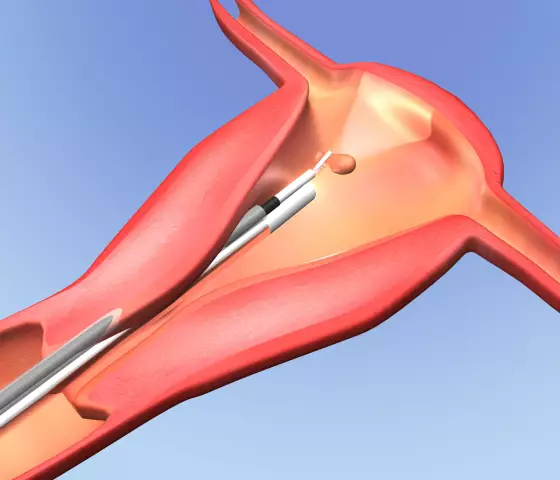- Author Rachel Wainwright [email protected].
- Public 2023-12-15 07:39.
- Last modified 2025-11-02 20:14.
Duodenal intubation

Duodenal intubation is a diagnostic procedure that is prescribed to examine the contents of the duodenum - a mixture of bile with intestinal, gastric and panktetic juice. Such a study makes it possible to assess the state of the biliary system, secretory function of the pancreas and prescribe it for inflammation of the gallbladder, diseases of the bile ducts and liver, occurring with the following symptoms: stagnant sputum in the gallbladder, a feeling of bitterness in the mouth, nausea, pain in the right hypochondrium, concentrated urine.
Preparation for duodenal intubation
Diagnose on an empty stomach in the morning. Dinner the night before should be light, while excluding potatoes, milk, brown bread and other foods that increase gas formation. 5 days before probing, you should stop taking choleretic drugs (tsikvalon, barberin, allochol, flamin, cholenism, holosas, liv-52, cholagol, barbara's salt, magnesium sulfate, sorbitol, xylitol), antispastic (no-spa, typhen, bellalgin, papaverine, bispan, belloid, belladonna), vasodilators, laxatives and those that improve digestion (panzinorm, abomin, pancreatin, festal, etc.).
In the process of preparing for duodenal intubation, the patient is given 8 drops of atropine - a 0.1% solution the day before (the drug can also be administered subcutaneously), and warm water with 30 g of xylitol is allowed to drink.
Duodenal sounding technique
To conduct the study, two techniques are used: classical duodenal intubation and fractional. The classical method is also called three-phase and is considered somewhat outdated, because The duodenal contents are taken in just three phases: from the duodenal gut, bile ducts, bladder and liver, thus obtaining duodenal, cystic and hepatic bile.
Fractional duodenal intubation includes five phases and the contents are pumped out every 5-10 minutes, which makes it possible to record its dynamics and the type of bile secretion:
- the first phase - portion A is released, which is taken when the probe enters the duodenum, before the administration of cholecystokinetic agents. The duodenal content at this stage consists of bile, pancreatic, intestinal and partially gastric juice. The phase lasts about 20 minutes.
- The second phase begins after the administration of magnesium sulfate and the cessation of bile secretion from the spasm of the sphincter of Oddi. The second phase of fractional duodenal intubation lasts 4-6 minutes.
- The third phase is the secretion of the contents of the extrahepatic biliary tract. Lasts 3-4 minutes.
- The fourth phase - allocation of portion B: emptying of the gallbladder, secretion of gallbladder thick bile of brown or dark yellow color.
- The fifth phase - begins after the dark cystic bile has ceased to be secreted and the bile of golden yellow color goes back (portion C). Bile is collected for half an hour.
For classical and fractional duodenal probing, a rubber probe is used, at the end of which there is a plastic or metal olive with holes for sampling. It is preferable to use a double probe as one of them pumps out the contents of the stomach.

In preparation for duodenal intubation, the distance from the patient's front teeth to the navel (in a standing position) is marked on the probe and three marks are put that make it possible to understand where the probe is located. After that, the patient is seated, an olive smeared with glycerin is placed behind the root of the tongue, and he is asked to breathe deeply and swallow. When the first mark is at the level of the incisors, it means that the probe presumably got into the stomach. The patient lies down on his right side and continues to swallow the probe. This should be done up to the second mark, indicating that the olive of the probe has approached the gatekeeper and after its next opening, he will be able to get into the duodenum (the third mark on the rubber tube of the probe). This usually happens after one or an hour and a half, and a golden liquid begins to flow from the probe - portion A, which is collected in test tubes.
A portion B is received 20-30 minutes after portion A and has the greatest diagnostic value.
This technique of duodenal intubation makes it possible to determine the capacity of the gallbladder, especially the separation of bile, to detect organic and functional disorders of bile secretion. All bile samples obtained in the process of probing are subjected to microscopic and bacteriological examination.
Found a mistake in the text? Select it and press Ctrl + Enter.






